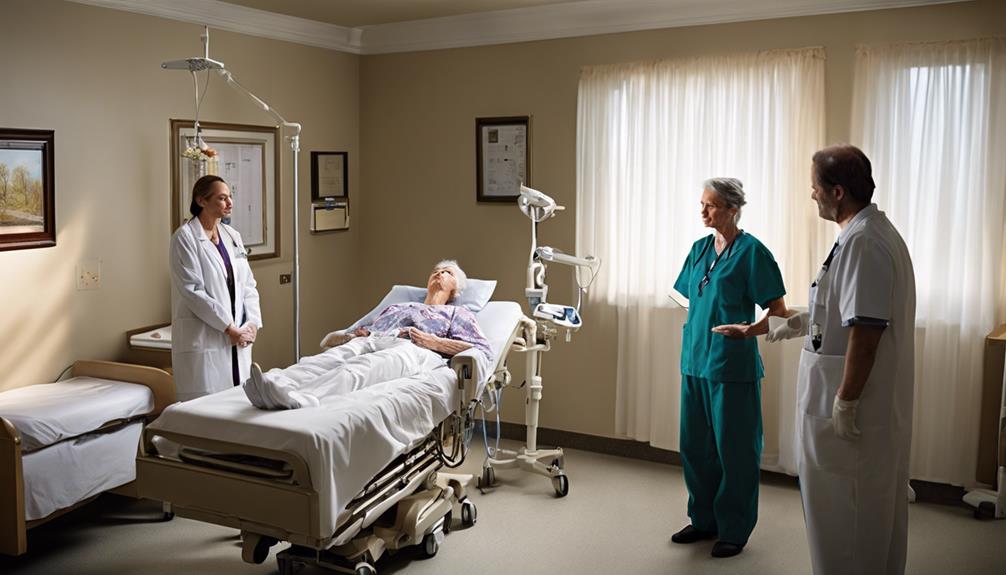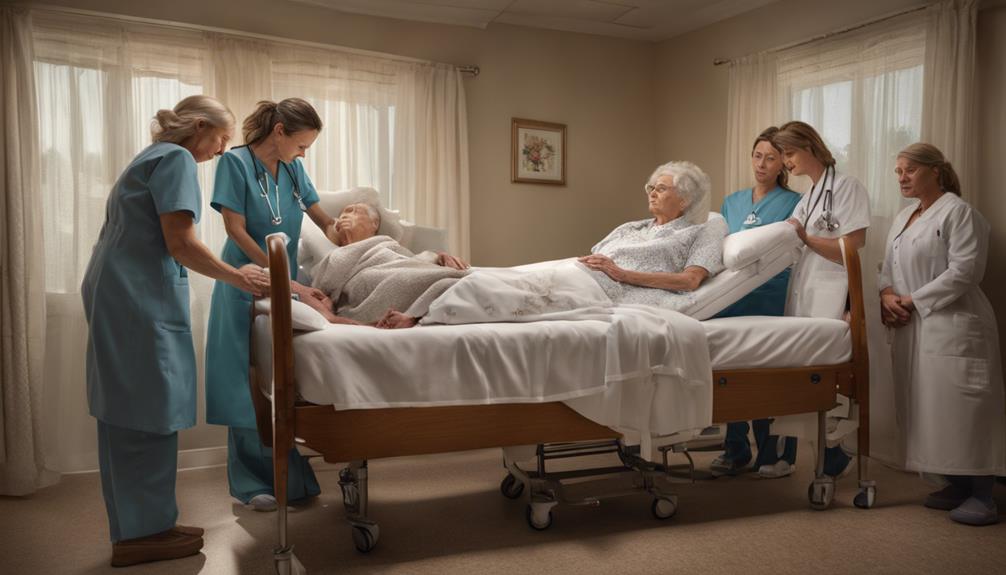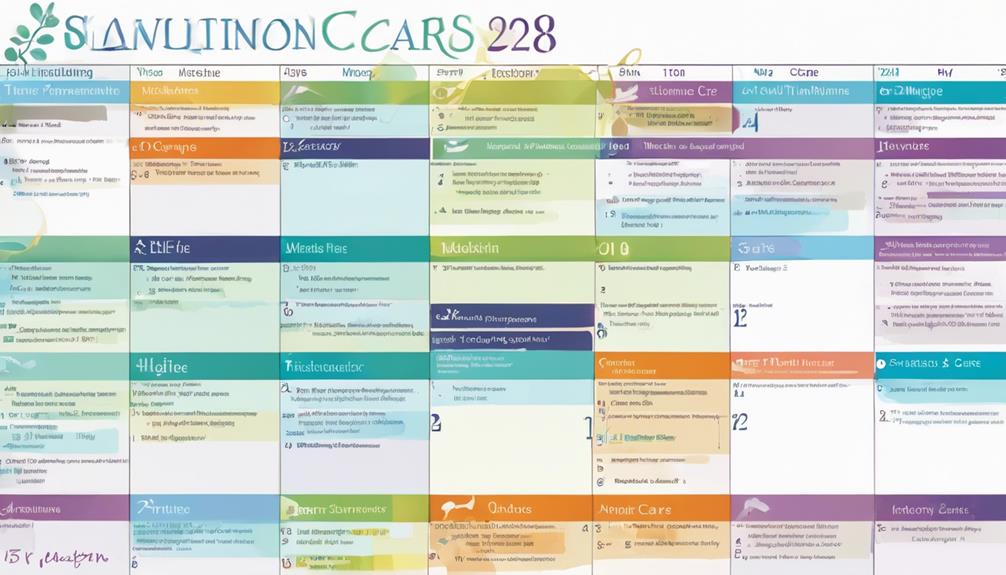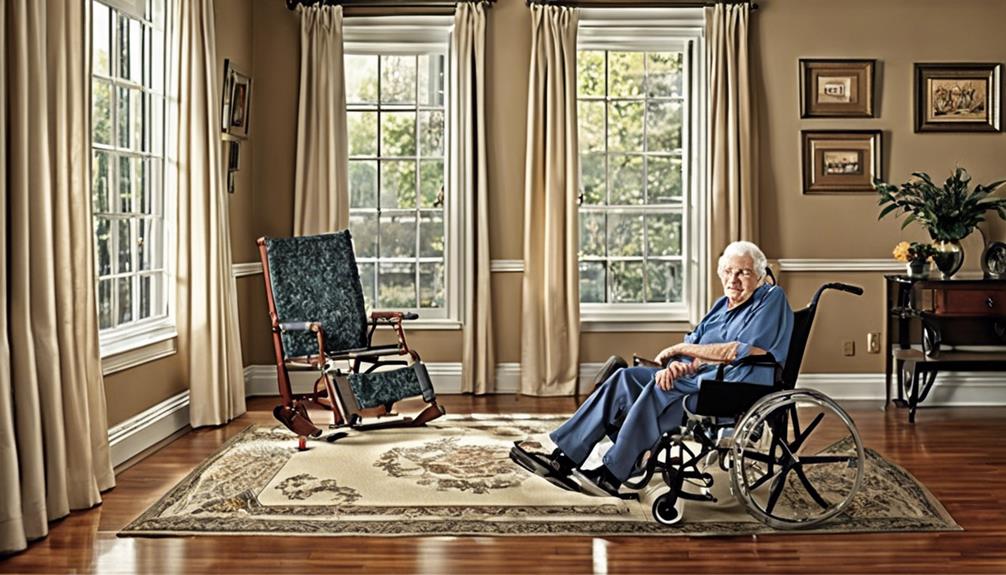Understanding the changing landscape of hospice care is crucial. This entails identifying different stages and indicators that signal the conclusion of life’s journey. Hospice care encompasses phases like the critical dying stage, during which patients may encounter weakness and challenges with swallowing. Caregivers extend empathetic assistance. Mental signs, such as altered cognition and agitation, are typical. Physical alterations like fluctuations in body temperature are tracked to provide solace. Acknowledging the progression towards the end of life enables caregivers to deliver essential aid. Veterans have access to VA coverage for hospice services. Patient-centered care prioritizes honoring individual preferences. Engage in gentle exercises and utilize specialized equipment to manage diminishing stamina. Generally, hospice care commences with a prognosis of six months or fewer.
Key Takeaways
- Hospice care involves stages, including the active dying phase with signs like weakness and decreased awareness.
- Psychological signs of transition may include altered thinking, confusion, restlessness, and communication with deceased loved ones.
- Physical changes in transition can manifest as body temperature fluctuations and breathing pattern changes.
- Recognizing end-of-life progression signs helps caregivers provide necessary support for patients.
- VA offers hospice coverage for qualifying veterans with terminal illnesses, including pain relief and emotional assistance.
Definition of Hospice Transition
What precisely does the term 'Hospice Shift' entail?
In hospice care, the dying process is divided into different stages, with one of them being the active dying phase. This phase is marked by significant physical changes as the body prepares for the final change. Patients may experience weakness, difficulty swallowing, and decreased awareness during this time. Hospice caregivers play an essential role in providing support and comfort to individuals going through this challenging period. They're trained to recognize the signs of active dying and provide compassionate care to manage symptoms and guarantee the comfort of the patient.
As individuals near the end of the active dying stage, they may exhibit signs such as unresponsiveness, changes in breathing, unfocused eyes, and bowel/bladder emptying. Understanding these physical changes and knowing how to respond with care and empathy is pivotal in hospice care. By being aware of these aspects of the dying process, caregivers can offer support that enhances the quality of life for patients during this difficult time.
Psychological Signs of Transition

During the hospice change process, psychological signs of moving may manifest as altered thinking, confusion, and agitation. Patients in transformation might experience restlessness, talk about past experiences, or even communicate with deceased loved ones. They may seem unaware of time, mention going on a trip, or express thoughts about seeing family members who've passed away.
As the shift progresses, patients could exhibit decreased awareness, weakness, and difficulty swallowing. Towards the end of the hospice journey, individuals may become unresponsive, have changes in breathing patterns, and show signs of bowel or bladder emptying.
It's important for caregivers and loved ones to provide support and comfort during this time, understanding that these psychological signs are a natural part of the evolving process. By being present, offering reassurance, and maintaining a peaceful environment, we can help ease the emotional aspects of this journey for those in hospice care.
Physical Changes in Transition
As individuals move into hospice care, they may experience variations in body temperature and shifts in their breathing patterns. These physical signs can be indicators that the body is adapting to the end-of-life process.
Observing these changes is essential in providing comfort and support during this pivotal phase.
Body Temperature Fluctuations
Body temperature fluctuations in hospice care are a common occurrence, often signaling the body's natural processes as it evolves towards the end-of-life phase. During the evolving stage in hospice care, patients may experience changes in body temperature due to these natural processes.
These fluctuations can serve as indicators that the body is preparing for the end-of-life phase. Caregivers play an essential role in monitoring and addressing any extreme changes in body temperature to guarantee the patient's comfort.
Hospice teams are equipped with the necessary training to provide support and guidance on managing body temperature fluctuations effectively. By understanding and responding to these fluctuations, caregivers can help guarantee the patient's comfort and well-being during this delicate stage of the hospice journey.
Breathing Pattern Changes
Understanding the significance of breathing pattern changes is essential in providing effective care during the shift phase in hospice settings. Breathing changes like rapid breathing or noisy breaths can occur during changing phases. Cheyne-Stokes breathing, where breaths alternate between deep and shallow, may also be present. Medications might be used to manage excessive secretions affecting breathing patterns.
Caregivers play a critical role in noticing and addressing these changes. Monitoring and addressing breathing patterns are essential for providing comfort care in hospice settings. By recognizing these changes early on, caregivers can guarantee the individual's comfort and support during this phase. It's important to be attentive and responsive to any breathing pattern changes to provide the best care possible.
End-of-Life Transition

Understanding the end-of-life shift in hospice care necessitates identifying the indications of active dying and offering empathetic support to terminally ill individuals. As individuals approach the end of life, they may exhibit a combination of physical changes and psychological signs that indicate the shift towards active dying.
To better comprehend this phase, let's look at some common signs that may occur during the end-of-life progression:
| Signs of End-of-Life Progression | Physical Changes | Psychological Signs |
|---|---|---|
| Altered thinking | Weakness | Unaware of time |
| Confusion | Difficulty swallowing | Talking about a trip |
| Agitation | Decreased awareness | Communicating with deceased loved ones |
| Restlessness |
Recognizing these signs can help caregivers provide the necessary support and comfort during this challenging time. By being attentive to both the physical and emotional needs of individuals in hospice care, we can ensure they receive the care and compassion they deserve as they navigate this final stage of life.
VA Coverage for Hospice

VA offers coverage for hospice care to qualifying veterans with terminal illnesses. This care includes pain relief, symptom management, and emotional assistance.
Veterans can access hospice services in various settings such as their homes, VA facilities, or through VA-approved providers.
VA Hospice Eligibility
Veterans with a terminal illness meeting specific criteria can access VA hospice coverage, ensuring tailored end-of-life care. To be eligible for VA hospice benefits, veterans must have a prognosis of 6 months or less to live.
Once qualified, veterans receive thorough care, pain management, and emotional support, benefiting both them and their families. VA hospice services can be provided at home or in a VA medical facility, depending on the veteran's preference.
This coverage guarantees that veterans receive quality end-of-life care that's personalized to meet their individual needs and preferences. It's a compassionate way for veterans to receive the support they deserve during this challenging time.
Benefits and Limitations
What key benefits and limitations are associated with VA coverage for hospice care?
VA coverage for hospice provides thorough end-of-life care for eligible veterans, offering medical care, emotional support, and assistance with daily activities. The focus is on improving quality of life, symptom management, and ensuring comfort in the final days.
However, limitations may exist due to specific eligibility criteria and coverage restrictions based on the veteran's circumstances. VA hospice services aim to support veterans and their families through a holistic approach to end-of-life care, providing palliative care that considers the physical, emotional, and spiritual needs of both the veteran and their loved ones.
It's important to engage with the VA hospice provider to understand the full scope of services available and the eligibility criteria required. This allows veterans and their families to make informed decisions about end-of-life care, ensuring they receive the necessary support. Furthermore, understanding the role of Pat Deegan in advanced directives can help individuals advocate for their preferences and maintain a sense of autonomy in their care. Engaging in these discussions early can provide peace of mind and a clear plan aligned with the veteran’s values and wishes.
Understanding POLST and MOLST

In healthcare, grasping POLST and MOLST is vital for guaranteeing that patients' end-of-life care wishes are clearly documented and honored. These legal documents outline an individual's preferences for life-sustaining treatments and are completed by healthcare professionals in collaboration with patients. Here are three key points to ponder:
- Patient-Centered Care: POLST and MOLST forms mirror the wishes of the patient regarding CPR, intubation, and other medical interventions, guiding healthcare providers in delivering care aligned with these preferences.
- Portability: These forms are portable, accompanying the patient across different healthcare settings. This ensures that the patient's end-of-life care wishes remain consistent and are respected wherever they receive treatment.
- Emergency Situations: In critical moments, such as emergencies, POLST and MOLST forms are essential for healthcare providers to quickly understand and implement the patient's preferences for life-sustaining treatments, avoiding unwanted interventions and promoting dignified care.
Communication in Hospice Care

Effective communication in hospice care plays a pivotal role in guaranteeing that patients' needs and concerns are understood and addressed with clarity and compassion. Open dialogue among the healthcare team, patients, and their loved ones fosters trust and helps in providing support during the end-of-life journey. Here is a table outlining the key aspects of communication in hospice care:
| Aspect | Description | Importance |
|---|---|---|
| Clear Language | Using simple, understandable words to convey information and address concerns effectively. | Guarantees comprehension |
| Active Listening | Paying attention to the patient's and family's needs, emotions, and preferences with empathy. | Builds trust and rapport |
| Emotional Support | Providing comfort, reassurance, and a safe space to express feelings during this challenging time. | Eases anxiety and distress |
| Answering Questions | Addressing queries about care, treatment, and the dying process to alleviate uncertainties. | Enhances understanding |
Effective communication in hospice care not only helps in coordinating care and managing symptoms but also guarantees that the wishes of the patient and their loved ones are respected and honored throughout the journey.
Managing Declining Energy and Mobility

As hospice patients experience declining energy and mobility, their daily activities may become increasingly challenging and restricted. It's vital to address these changes with sensitivity and care to safeguard the comfort and quality of life of the individual receiving end-of-life care. Hospice care providers offer personalized care plans that focus on managing declining energy and mobility effectively.
Here are some key strategies that may be implemented:
- Gentle Exercises: Incorporating gentle exercises tailored to the patient's abilities can help maintain muscle strength and flexibility, improving overall mobility and comfort.
- Positioning Aids: Using specialized positioning aids can assist in reducing discomfort and preventing pressure ulcers for individuals with limited mobility.
- Specialized Equipment: Providing access to specialized equipment such as wheelchairs or walkers can enhance mobility and independence, contributing to a better quality of life during this phase.
Timeline for Transition in Hospice

Exploring the hospice journey involves understanding the timeline for moving into this specialized care approach, which usually occurs when a patient has a prognosis of 6 months or less to live. As individuals reach the final stage of life, hospice becomes essential in providing comfort and support. The shift to hospice signifies a move towards focusing on quality of life rather than curative measures. During this period, the hospice team closely monitors vital signs and offers round-the-clock assistance.
In the imminent approach of death, the hospice team plays a pivotal role in ensuring that the patient's needs are met with compassion and expertise. They provide tailored medical care, assistance with daily activities, emotional support, and bereavement care for both the patient and their loved ones. Understanding the timeline for moving into hospice can help families prepare for this significant change and make the most out of the support and care offered during this challenging time.
Frequently Asked Questions
How Does Hospice Know When Someone Is Transitioning?
We identify entering the end-of-life care phase by observing physical changes like altered breathing patterns, reduced consciousness, appetite, thirst, and skin color shifts. Indicators such as skin mottling, temperature fluctuations, and essential sign variations also suggest the progression.
What Is Transitioning During the Dying Process?
We experience evolving during the dying process as a natural progression. It involves signs like altered thinking, confusion, and physical changes. These shifts can be emotional but are part of our journey towards the end of life.
How Long Does the Transition Phase of Dying Last?
We help you understand. The phase of dying in hospice varies. Factors like health and illness impact its duration. Some move quickly, others take longer. Hospice offers comfort and support through this process.
What Happens When You Transition to Hospice?
What occurs when we shift to hospice? We are provided with compassionate care that emphasizes comfort, quality of life, and holistic support. A team of experts leads us through this process, providing medical aid, emotional backing, and care coordination.
Conclusion
In summary, shifting in hospice can be a challenging and emotional process, but it's important to understand the signs and changes that may occur.
One common objection is the fear of losing control, but hospice care aims to provide comfort and support during this time.
By communicating openly with healthcare providers and loved ones, managing physical and emotional changes, and utilizing available resources, the shift in hospice can be navigated with compassion and dignity.









